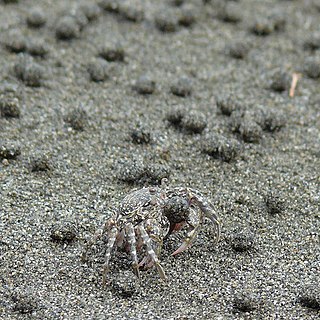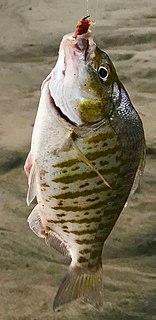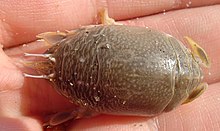
The sanderling is a small wading bird. The name derives from Old English sand-yrðling, "sand-ploughman". The genus name is from Ancient Greek kalidris or skalidris, a term used by Aristotle for some grey-coloured waterside birds. The specific alba is Latin for "white".

Ghost crabs are semiterrestrial crabs of the subfamily Ocypodinae. They are common shore crabs in tropical and subtropical regions throughout the world, inhabiting deep burrows in the intertidal zone. They are generalist scavengers and predators of small animals. The name "ghost crab" derives from their nocturnality and their generally pale coloration. They are also sometimes called sand crabs, though the name refers to various other crabs that do not belong to the subfamily.

Giovanni Antonio Scopoli was an Austrian physician and naturalist. His biographer Otto Guglia named him the "first anational European" and the "Linnaeus of the Austrian Empire".

Mary Jane Rathbun was an American zoologist who specialized in crustaceans. She worked at the Smithsonian Institution from 1884 until her death. She described more than a thousand new species and subspecies and many higher taxa.
The common term sand crab can refer to various species of crustacean:

The bird genus Apus comprise some of the Old World members of the family Apodidae, commonly known as swifts.

Sand bubbler crabs are crabs of the genera Scopimera and Dotilla in the family Dotillidae. They are small crabs that live on sandy beaches in the tropical Indo-Pacific. They feed by filtering sand through their mouthparts, leaving behind balls of sand that are disintegrated by the incoming high tide.
As ocean surface waves approach shore, they get taller and break, forming the foamy, bubbly surface called surf. The region of breaking waves defines the surf zone, or breaker zone. After breaking in the surf zone, the waves continue to move in, and they run up onto the sloping front of the beach, forming an uprush of water called swash. The water then runs back again as backwash. The nearshore zone where wave water comes onto the beach is the surf zone. The water in the surf zone is shallow, usually between 5 and 10 m deep; this causes the waves to be unstable.

Hippoidea is a superfamily of decapod crustaceans known as sand crabs, mole crabs, sand bugs, or sand fleas.

The barred surfperch is a species of surfperch native to inshore waters from northern California, United States to southern Baja California, Mexico. This species can reach a length of 43 centimetres (17 in) TL though most do not exceed 30 centimetres (12 in) TL. The maximum recorded weight is 2.0 kilograms (4.4 lb). Like other surfperches, it gives birth to live young. The diet of the barred surfperch consists predominantly of sand crabs .
According to the California Department of Fish and Game, Barred Surfperch can be identified by bars and spots on sides which are often unbarred, as well as the absence of red tail.

Profilicollis is a genus of acanthocephalan parasites of crustaceans. The status of the genus Profilicollis has been debated, and species placed in this genus were formerly included in the genus Polymorphus. However, research on the morphology of the group and their use of hosts has concluded that Profilicollis and Polymorphus should be regarded as distinct genera, and species previously described as Polymorphus altmani are now referred to as Profilicollis altmani in taxonomic and biological literature. Profilicollis parasites infect decapod crustaceans, usually shore crabs, as intermediate hosts, and use many species of shorebirds as definitive (final) hosts.

The redtail surfperch is a marine fish that inhabits the near-shore and estuarine waters of North American Pacific coasts.

Ocypode gaudichaudii, also known as the painted ghost crab or cart driver crab, is a species of crab found on Pacific beaches from El Salvador to Chile as well as on the Galápagos Islands. The species was first described by Henri Milne-Edwards and Hippolyte Lucas in 1843.

Emerita analoga, the Pacific sand crab or Pacific mole crab, is a species of small, sand-burrowing decapod crustacean found living in the sand along the temperate western coasts of North and South America. It is found on exposed sandy beaches in the swash region of the intertidal zone.
Emerita rathbunae is a species of "mole crabs" or "sand crabs" in the genus Emerita that lives along the tropical Pacific coasts of the Americas.

Albunea carabus is a rare species of "sand crab" or "mole crab" in the genus Albunea. It lives in shallow, turbulent waters in sandy areas of the tropical eastern Atlantic Ocean and the Mediterranean Sea.

The gulf ghost crab, Hoplocypode occidentalis, is a species of ghost crabs native to the Pacific coast of the Americas, from the Gulf of California to Colombia. It is the only species in the genus Hoplocypode. Gulf ghost crabs are medium-sized, reaching a maximum overall body diameter of 6 in (15 cm). They are one of only two ghost crab species found in the eastern Pacific. However, gulf ghost crabs can easily be distinguished from painted ghost crabs by the absence of "horns" on their eyes.

Ocypode africana, commonly known as the African ghost crab, is a species of ghost crabs native to the eastern Atlantic coast of western Africa, from Mauritania to Namibia. They are medium-sized ghost crabs reaching carapace width of 3.4 cm (1.3 in). They can vary in coloration from pinkish to dark grey. They are one of only two ghost crab species found in the eastern Atlantic. However, African ghost crabs can easily be distinguished from tufted ghost crabs by the absence of long tufts of hair on the tip of their eyestalks.

Hippa adactyla is a species of small, sand-burrowing decapod crustacean found living along the coasts of Indo-West Pacific waters. It is found on exposed sandy beaches in the swash region of the intertidal zone.

Emerita talpoida, known generally as the Atlantic mole crab or Atlantic sand crab, is a species of mole crab in the family Hippidae. It is found in the western Atlantic Ocean and Mexico along the shoreline.



















